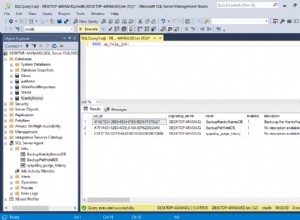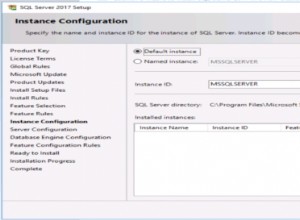Se bem entendi, você quer calcular a diferença entre a data de início e término excluindo o horário antes das 10h e depois das 19h.
Aqui está a consulta de exemplo e o violino sql.
SELECT start_time,
finish_time,
interval_time,
EXTRACT (HOUR FROM interval_time), --extract the hours,mins and seconds from the interval
EXTRACT (MINUTE FROM interval_time),
EXTRACT (SECOND FROM interval_time)
FROM (SELECT start_time,
finish_time,
NUMTODSINTERVAL (
CASE
WHEN finish_time - TRUNC (finish_time) > (19 / 24) --if finish time is after 7pm
THEN
TRUNC (finish_time) + (19 / 24) --set it to 7pm
ELSE
finish_time --else set it to actual finish time
END
- CASE
WHEN start_time - TRUNC (start_time) < (10 / 24) --if start time is before 10 am
THEN
TRUNC (start_time) + (10 / 24) --set it to 10 am.
ELSE
start_time --else set it to the actual start time
END,
'day') --subtract the both and convert the resulting day to interval
interval_time
FROM timings);
O que tenho feito é,
- Verifique se o horário de início é antes das 10h e o horário de término é depois das 19h. Em caso afirmativo, defina o horário para 10h e 19h.
- Em seguida, subtraia as datas e converta os dias resultantes para o tipo de intervalo.
- Em seguida, extraia as horas, minutos e segundos do intervalo.
Observação: Esta consulta assume que ambas as datas caem no mesmo dia e ambas não são antes das 10h ou depois das 19h.
ATUALIZAÇÃO: Para excluir feriados, a consulta ficará complicada. Sugiro escrever três funções e usar essas funções na consulta.
1ª função:
FUNCTION modify_start_time (p_in_dte DATE) RETURN DATE
----------------------------------
IF p_in_dte - TRUNC (p_in_dte) < (10 / 24)
THEN
RETURN TRUNC (p_in_dte) + (10 / 24);
ELSIF p_in_dte - TRUNC (p_in_dte) > (19 / 24)
THEN
RETURN TRUNC (p_in_dte) + 1 + (10 / 24);
ELSE
RETURN p_in_dte;
END IF;
Se o horário de início estiver fora do horário de trabalho, modifique o horário de início para o horário de início mais próximo.
2ª função:
FUNCTION modify_finish_time (p_in_dte DATE) RETURN DATE
----------------------------------
IF p_in_dte - TRUNC (p_in_dte) > (19 / 24)
THEN
RETURN TRUNC (p_in_dte) + (19 / 24);
ELSIF p_in_dte - TRUNC (p_in_dte) < (10 / 24)
THEN
RETURN TRUNC (p_in_dte) - 1 + (19 / 24);
ELSE
RETURN p_in_dte;
END IF;
Se o horário de término estiver fora do horário de trabalho, modifique-o para o horário de término mais próximo anterior.
3ª função:
FUNCTION get_days_to_exclude (p_in_start_date DATE,
p_in_finish_date DATE) RETURN NUMBER
--------------------------------------------------------
WITH cte --get all days between start and finish date
AS ( SELECT p_in_start_date + LEVEL - 1 dte
FROM DUAL
CONNECT BY LEVEL <= p_in_finish_date + 1 - p_in_starT_date)
SELECT COUNT (1) * 9 / 24 --mutiply the days with work hours in a day
INTO l_num_holidays
FROM cte
WHERE TO_CHAR (dte, 'dy') = 'sun' --find the count of sundays
OR dte IN --fins the count of holidays, assuming leaves are stored in separate table
(SELECT leave_date
FROM leaves
WHERE leave_date BETWEEN p_in_start_date
AND p_in_finish_date);
l_num_holidays :=
l_num_holidays + ( (p_in_finish_date - p_in_start_date) * (15 / 24)); --also, if the dates span more than a day find the non working hours.
RETURN l_num_holidays;
Esta função encontra o número de dias a serem excluídos ao calcular a duração.
Então, a consulta final deve ser algo assim,
SELECT start_time,
finish_time,
CASE
WHEN work_duration < 0 THEN NUMTODSINTERVAL (0, 'day')
ELSE NUMTODSINTERVAL (work_duration, 'day')
END
FROM (SELECT start_time, finish_time,
--modify_start_time (start_time), modify_finish_time (finish_time),
modify_finish_time (finish_time)
- modify_start_time (start_time)
- get_days_to_exclude (
TRUNC (modify_start_time (start_time)),
TRUNC (modify_finish_time (finish_time)))
work_duration
FROM timings);
Se a duração for menor que 0, ignore-a configurando-a como 0.




